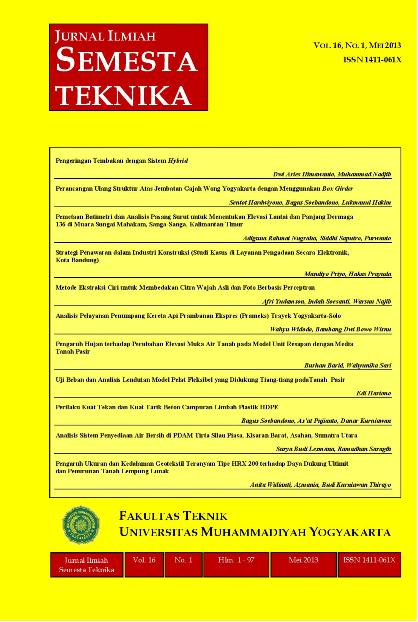Perilaku Kuat Tekan dan Kuat Tarik Beton Campuran Limbah Plastik HDPE
DOI:
https://doi.org/10.18196/st.v16i1.435Abstract
Concrete is one of the most commonly used materials for construction. Due to the increased of concrete demand, the need for alternative material to substitute natural aggregate becomes crucial. In this study HDPE plastic waste was used as artificial aggregate. HDPE was mixed with natural coarse aggregate at variation of 0%, 10%, 15% and 20%. Compressive test and split tensile tests were performed on concrete age of 28 days. The compressive strength of concrete decreased with the addition of HDPE levels. The result shows that the highest value of compressive strength was 27,88 MPa on 0% HDPE and the lowest value was 11,08 MPa on 20% HDPE mixture. The highest split tensile strength achieved by normal concrete of 2,71 MPa. Split tensile strength of concrete gradually decreased with the addition of HDPE variations. The lowest value of tensile strength was obtained from variation of 20% HDPE plastic waste that is equal to 1.72 MPa. From the analysis it can be concluded that the replacement of coarse aggregate crushed stone with HDPE plastic waste reduce split tensile strength of concrete.
Downloads
Published
How to Cite
Issue
Section
License
Semesta Teknika is licensed under a Creative Commons Attribution 4.0 International License.
Authors who publish with this journal agree to the following terms:
- Authors retain copyright and grant the journal right of first publication with the work simultaneously licensed under a Creative Commons Attribution License that allows others to share the work with an acknowledgement of the work's authorship and initial publication in this journal.
- Authors are able to enter into separate, additional contractual arrangements for the non-exclusive distribution of the journal's published version of the work (e.g., post it to an institutional repository or publish it in a book), with an acknowledgement of its initial publication in this journal.
- Authors are permitted and encouraged to post their work online (e.g., in institutional repositories or on their website) prior to and during the submission process, as it can lead to productive exchanges, as well as earlier and greater citation of published work (See The Effect of Open Access).









